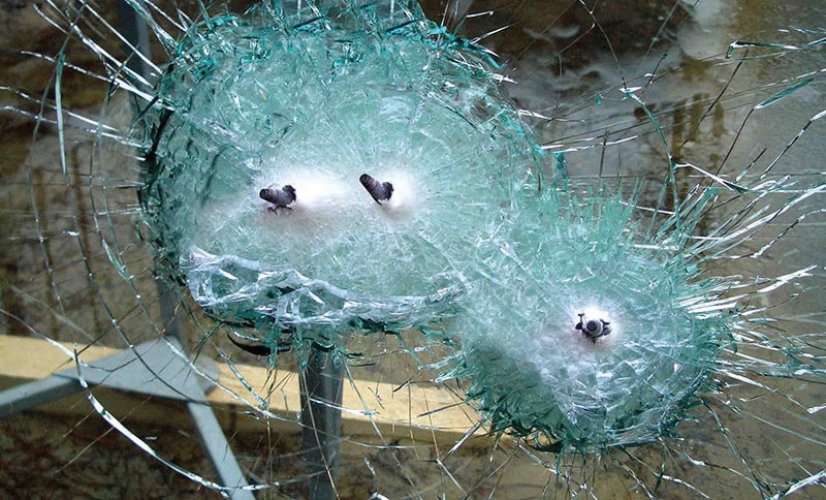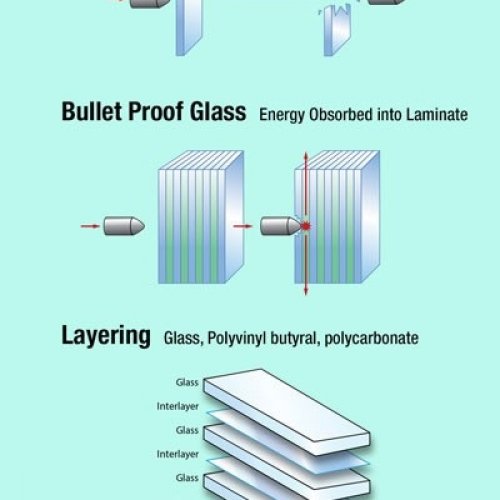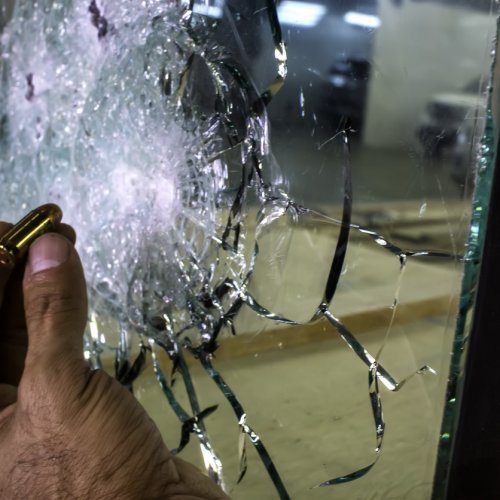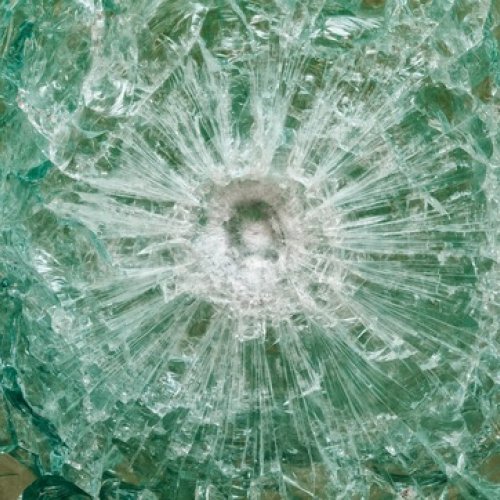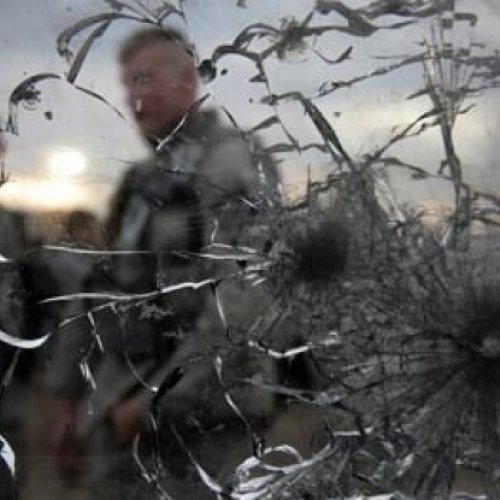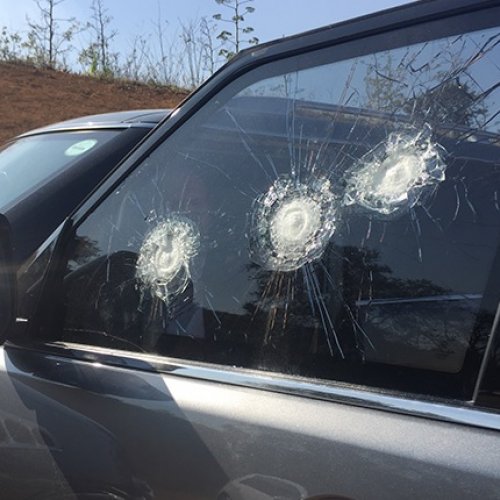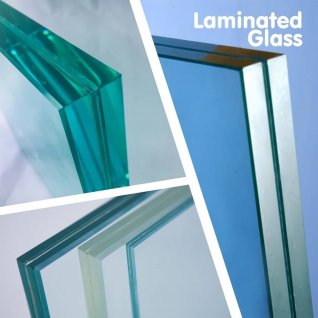Bulletproof glass is produced by the process of lamination, where in multiple sheets of glass with PVB films in between are subjected to very high pressure and temperature, resulting into an agglomerate compact aggregate.
The components (glass) bonded together can be either transparent or colored or extra white, or even energy, so the final result beside the bulletproof behavior has other characteristics (decorative, thermal insulation, etc.).
Holes and slots are possible if not surpass by some normal limits also applying to plain glass.
Finally, it is also possible to construct curved bullet-proof glass, with limited radius of curvature.
Properties
The European Standard EN1063 categorizes ballistic glazing according to their resistance to various types of guns and ammunition. It defines glazing resistant to bullets; the glazing must withstand a specified load against shot from the firearm and ammunition.
Based on the same arms and ammunition as the variety of weapons does not allow to take them all into consideration. The primary function of the bulletproof glass is the prevention of penetration by ball or bullet in the protected area. However in some cases this may not be enough and it may require in additional shock to the remaining unbroken part after, so to avoid the broken glass splinters to fall into the protected space. This is feasible if we add more glass sheets and membranes that to safeguard personnel (or sensitive and valuable material) from injury by fragments of glass which can be thrown from the back side of the glazing. This qualitative differentiation is controlled during the test via a 'control-plate' consisting of an aluminum foil positioned behind the tested product. The laminate must not be pierced by glass fragments during the test in order to ensure that the product designation NS (NON SPALLING). Otherwise it gets characterized S (SPALLING).
The protection provided by bulletproof glazing depends on the one hand of its design, mounting and maintenance of the whole installation, and on the other hand the glass itself. Advices for installing bulletproof glass provided by BS 5357: 1995 are in the Code of Practice for the Installation of safety glazing. The requirements and classifications of bulletproof glass for windows, doors and blinds, defined in EN 1522: 1998 in accordance with the test procedures defined in EN1523: 1998.
The individual components (panes and films) which are used, ensure transparency and aesthetic neutrality of the final product. However because of the increased thickness, which is a necessary evil for a bulletproof glass pane, it has green shade. Often the individual panes selected to be extra-quality so the final product color is neutral.
The total thickness, weight and composition of the final product, varies and depends solely on the nominal caliber of the bullet from which we want guaranteed to retain the glazing for. The durability, appearance and other technical characteristics of ballistic glazing remain inalienable from sun exposure. However, if you have used color and / or thermo repellents ingredients, you should not underestimate the possibility of thermal shock. In such cases, the solution consists in the circumferential abrasion to protect the edges from possible stress.
Another intrinsic property of all bulletproof glass, is the excellent soundproofing, which is obvious when talking about massive glass with repeated intermediate elastomeric films. Also, bulletproof glass, by definition, provides excellent protection from ultraviolet radiation (UV).
Bulletproof glazing: BS5051
This standard specifies performance requirements and test methods for six classes of bulletproof glazing indoors, designed to resist attack from handguns, rifles and shotguns.
Categories of bulletproof glasses
The classification of types of bulletproof safety glass follows a nomenclature which corresponds to specific performance as checked/measured according to a specific methodology which are described in the European standard EN356.
These categories were ranked based on the following performance:
| Category | Caliber | Weapon | Projectile Speed | Nr. of Shoots |
|---|---|---|---|---|
| BR1 | 0,22 Long rifle | Long rifle | 360m/s | 3 |
| BR2 | 9mm parabellum | Luger, Uzi | 400 m/s | 3 |
| BR3 | 0,357 magnum | Magnum | 430 m/s | 3 |
| BR4 | 0,44 magnum | Magnum | 440 m/s | 3 |
| BR5 | 5,56 x 45mm | M16 | 950 m/s | 3 |
| BR6 | 7,62 x 51mm soft core | FAL / Winchester | 820 m/s | 3 |
| BR7 | 7,62 x 51mm hard core | FAL | 830 m/s | 3 |
| SG1 | 12 / 70 | Riotgun | 420 m/s | 1 |
| SG2 | 12 / 70 | Riotgun | 420 m/s | 3 |
From the above table, it is obvious that according to the European standard classification of a safety glazing is INDEPENDENT of its composition and depends ONLY on the performance of resilience during the test procedure. It is logical and over time the newer technologies for material give new products with less weight to achieve better performance and thus obtain higher security certificates.
It is a technological breakthrough and the target of the global glass industry is to launch on the market new glasses which are less thick and have less weight in order to meet better results in conditions of mechanical tiredness.
- Banks
- Guard houses
- Police stations
- Prisons
- Barracks
- Military vehicles
- Remittance vehicles
- Cashiers
- Offices
- Residences


